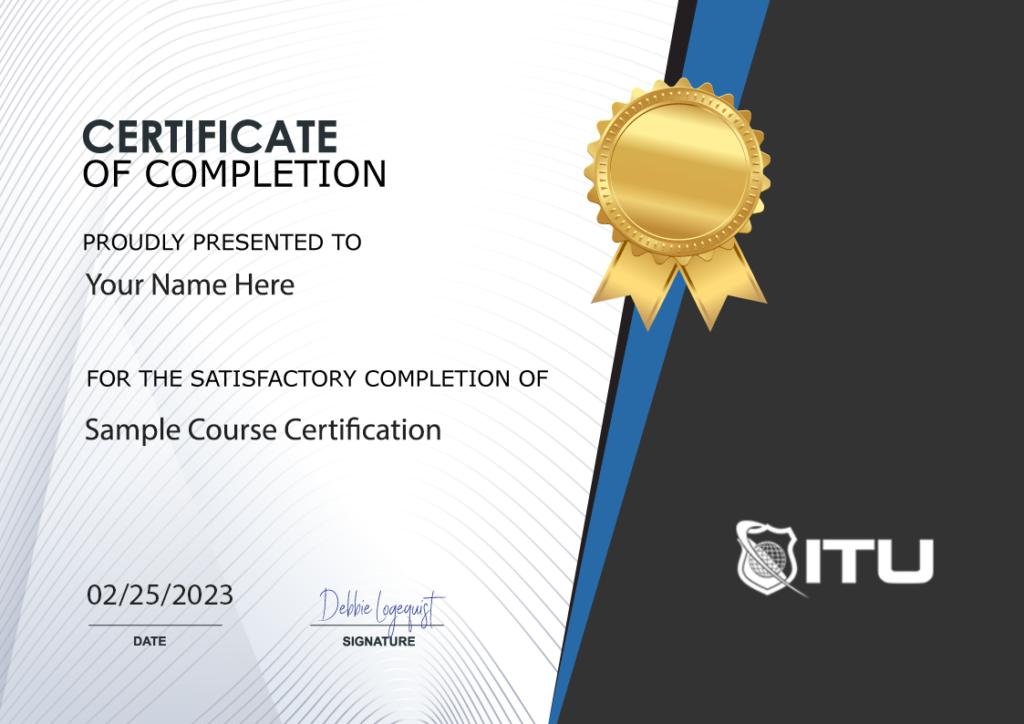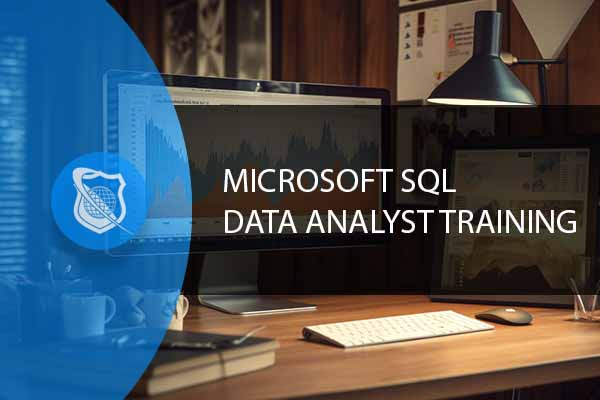Microsoft SQL Data Analysis Training Series – 3 Courses
Become a Microsoft SQL server expert today with this Microsoft SQL Data Analysis Training Series course that contains everything you need to know! It includes Databases, Administration and an introduction to Power BI which will all help set yourself up for success in the future. Having these skills under your belt will be highly beneficial when it comes to job opportunities and salary growth – so don’t wait any longer; get started now!
Included In This Course



Closed Captions



Certificate of Completion
Course Description for Microsoft SQL Server 2019 Data Analysis
This comprehensive course on Microsoft SQL Server 2019 Data Analysis covers the essential tools and techniques needed to effectively analyze data using SQL Server. Participants will learn how to use various query tools, master T-SQL querying, and explore business intelligence and data modeling concepts. The course also delves into practical applications of SQL for data analysis, including creating reports and dashboards with Power BI.
Throughout the course, learners will gain hands-on experience with SQL Server Management Studio, command-line query tools, and the latest features in SQL Server 2019. By the end of the course, students will be equipped to handle complex data analysis tasks and leverage SQL Server’s powerful capabilities to drive data-driven decision-making in real-world scenarios.
What You Will Learn in Microsoft SQL Server 2019 Data Analysis
By enrolling in this course, you will gain a thorough understanding of SQL Server 2019’s data analysis capabilities. You will acquire skills to efficiently manage and query data, design data models, and create insightful reports and dashboards. Key learning outcomes include:
- Understanding and using SQL Server Management Studio and command-line query tools.
- Mastering T-SQL querying, including SELECT statements, joins, and filtering data.
- Exploring business intelligence concepts and data modeling techniques.
- Transforming and loading data using Power BI.
- Designing data models with relationships and row-level security.
- Creating reports and dashboards with advanced features in Power BI.
- Performing advanced analytics and utilizing Power Apps visuals.
Who This SQL Server 2019 Data Analysis Course is For
This course is designed for a wide range of learners, including:
- Data analysts and business intelligence professionals looking to enhance their SQL skills.
- Database administrators and developers seeking to expand their knowledge of data analysis.
- Beginners in data analysis who want to start with SQL Server 2019.
- IT professionals aiming to leverage SQL Server for data-driven insights.
Possible Jobs You Can Get With This Knowledge
Acquiring skills in SQL Server 2019 data analysis can open up various career opportunities in the field of data analytics and beyond. Some potential job titles include:
- Data Analyst
- Business Intelligence Analyst
- SQL Developer
- Database Administrator
- Data Scientist
- Business Data Analyst
Average Industry Salaries for People with These Skills
Professionals skilled in SQL Server data analysis can expect competitive salaries across various industries. Approximate average salary ranges include:
- Data Analyst: $60,000 – $90,000
- Business Intelligence Analyst: $70,000 – $100,000
- SQL Developer: $75,000 – $110,000
- Database Administrator: $80,000 – $120,000
- Data Scientist: $90,000 – $140,000
Get Started Today with Microsoft SQL Server 2019 Data Analysis
Don’t miss the opportunity to advance your career with our Microsoft SQL Server 2019 Data Analysis course. Enroll today to gain the skills and knowledge needed to excel in the field of data analysis. With expert-led instruction and hands-on practice, you’ll be well-prepared to tackle real-world data challenges and drive meaningful insights for your organization.
Join now and take the first step towards becoming a proficient data analyst with SQL Server 2019!
Key Term Knowledge Base: Key Terms Related to Microsoft SQL Server 2019 Data Analysis
Understanding the key terms related to Microsoft SQL Server 2019 Data Analysis is crucial for anyone working in data analysis, database management, or business intelligence. These terms will help you navigate the tools and concepts covered in the course, enabling you to effectively analyze and manage data within SQL Server and related technologies.
| Term | Definition |
|---|---|
| SQL Server Management Studio (SSMS) | An integrated environment for managing any SQL infrastructure, from SQL Server to Azure SQL Database. |
| T-SQL (Transact-SQL) | An extension of SQL used by SQL Server, adding procedural programming, local variables, and error handling. |
| SELECT Statement | A SQL command used to fetch data from a database. |
| JOIN | A SQL operation for combining data from two or more tables based on a related column between them. |
| INNER JOIN | A type of join that returns only the rows that have matching values in both tables. |
| OUTER JOIN | A type of join that returns all rows from one table and the matched rows from the second table. If there is no match, the result is NULL on the side of the table that doesn’t have a match. |
| Self Join | A regular join but the table is joined with itself. |
| Cross Join | A join operation that produces the Cartesian product of two tables. |
| DISTINCT | A SQL keyword used to return only distinct (different) values. |
| CASE Expression | A SQL expression used to evaluate conditions and return a value when the first condition is met. |
| Business Intelligence (BI) | Technologies, applications, and practices for the collection, integration, analysis, and presentation of business information. |
| Data Modeling | The process of creating a data model for the data to be stored in a database, defining the logical structure and relationships. |
| ETL (Extract, Transform, Load) | A process in database usage and especially in data warehousing that involves extracting data from outside sources, transforming it to fit operational needs, and loading it into the end target. |
| Data Warehouse | A central repository of integrated data from one or more disparate sources, used for reporting and data analysis. |
| Power BI | A business analytics tool by Microsoft that provides interactive visualizations and business intelligence capabilities with an interface simple enough for end users to create their own reports and dashboards. |
| DAX (Data Analysis Expressions) | A collection of functions, operators, and constants that can be used in a formula or expression to calculate and return one or more values in Power BI, Power Pivot, and Analysis Services. |
| Measures | Calculations used in data analysis that are created using DAX and used to aggregate data in a meaningful way. |
| Calculated Columns | Columns created using DAX formulas that add data to a table and are calculated row by row. |
| Row-Level Security (RLS) | A security feature in Power BI that restricts data access for given users based on filters defined within roles. |
| Dashboards | Single-page, often real-time summaries of data that provide an overview of key metrics and KPIs. |
| Paginated Reports | Reports formatted to fit well on a page and that display all the data in a table, even if the table spans multiple pages. |
| Advanced Analytics | The use of sophisticated techniques and tools to model data, predict future outcomes, and gain insights from complex datasets. |
| Power Apps | A suite of apps, services, connectors, and a data platform that provides a rapid development environment to build custom apps for your business needs. |
| Kubernetes | An open-source container orchestration platform that automates deploying, scaling, and managing containerized applications. |
| Docker | An open platform for developing, shipping, and running applications inside lightweight, portable containers. |
| Hadoop | An open-source framework that allows for the distributed processing of large data sets across clusters of computers using simple programming models. |
| Spark | An open-source unified analytics engine for large-scale data processing, with built-in modules for streaming, SQL, machine learning, and graph processing. |
| PolyBase | A data virtualization feature in SQL Server that allows querying of external data sources using T-SQL. |
| HDFS (Hadoop Distributed File System) | A distributed file system designed to run on commodity hardware and to store and manage large volumes of data across multiple machines. |
| Machine Learning Services | Services in SQL Server that allow the integration and execution of machine learning models directly within the database. |
| MLeap | An open-source library that provides a serialization format and execution engine for machine learning pipelines. |
| SSIS (SQL Server Integration Services) | A component of SQL Server that can be used to perform a wide range of data migration tasks. |
Frequently Asked Questions About Microsoft SQL Data Analysis Training Series
What topics are covered in the Microsoft SQL Server 2019 Data Analysis course?
The course covers a wide range of topics including query tools, T-SQL querying, business intelligence and data modeling, data transformation and loading using Power BI, report and dashboard creation, advanced analytics, and the use of Power Apps visuals.
Who is the Microsoft SQL Server 2019 Data Analysis course for?
This course is ideal for data analysts, business intelligence professionals, database administrators, developers, beginners in data analysis, and IT professionals who want to enhance their SQL skills and leverage SQL Server for data-driven insights.
What skills will I gain from the Microsoft SQL Server 2019 Data Analysis course?
You will gain skills in using SQL Server Management Studio, T-SQL querying, business intelligence and data modeling, transforming and loading data with Power BI, designing data models, creating reports and dashboards, performing advanced analytics, and utilizing Power Apps visuals.
What career opportunities are available with SQL Server 2019 data analysis skills?
With SQL Server 2019 data analysis skills, you can pursue careers as a Data Analyst, Business Intelligence Analyst, SQL Developer, Database Administrator, Data Scientist, or Business Data Analyst.
What are the average industry salaries for SQL Server data analysis professionals?
Average salaries for SQL Server data analysis professionals range from $60,000 to $140,000, depending on the specific job title and level of experience. For example, Data Analysts typically earn between $60,000 and $90,000, while Data Scientists can earn between $90,000 and $140,000.
Proudly DisplayYour Achievement
Upon completion of your training, you’ll receive a personalized certificate of completion to help validate to others your new skills.
Microsoft SQL Server 2019 - Introduction to Data Analysis Course Content
Module 1 - Query Tools
- 1.1 Course Introduction
- 1.2 Intro to Management Studio
- 1.3 Intro to command-line query tools
Module 2 - Introduction to T-SQL Querying
- 2.1 Introducing T-SQL
- 2.2 Understanding Sets
- 2.3 Understanding the Logical Order of Operations in SELECT statements
Module 3 - Basic SELECT Queries
- 3.1 Writing Simple SELECT Statements
- 3.2 Eliminate Duplicates with DISTINCT
- 3.3 Using Column and Table Aliases
- 3.4 Write Simple CASE Expressions
Module 4 - Querying Multiple Tables
- 4.1 Understanding Joins
- 4.2 Querying with Inner Joins
- 4.3 Querying with Outer Joins
- 4.4 Querying with Cross Joins and Self Joins
Module 5 - Sorting and Filtering Data
- 5.1 Sorting Data
- 5.2 Filtering Data with Predicates
- 5.3 Filtering with the TOP and OFFSET-FETCH
- 5.4 Working with Unknown Values
Module 6 - Introduction to Business Intelligence and Data Modeling
- 6.1 Introduction to Business Intelligence
- 6.2 The Microsoft Business Intelligence Platform
- 6.3 Exploring a Data Warehouse
- 6.4 Exploring a Data Model
Module 7 - Prepare Data
- 7.1 Introduction to Power BI
- 7.2 Get data from various data sources
- 7.3 Preview source data
Module 8 - Clean, Transform, and Load Data
- 8.1 Data Transformation Intro
- 8.2 Transformation Example 1
- 8.3 Transformation Example 2
- 8.4 Transformation Example 3
- 8.5 Transformation Example 4
- 8.6 Transformation Example 5
- 8.7 Transformation Example 6
Module 9 - Design a Data Model
- 9.1 Introduction to Data Modeling
- 9.2 Model Relationships
- 9.3 Table Configuration
- 9.4 Model interface
- 9.5 Quick Measures
- 9.6 Many-to-many relationships
- 9.7 Row-level security
Module 10 - Create Model Calculations using DAX
- 10.1 DAX context
- 10.2 Calculated Tables
- 10.3 Calculated Columns
- 10.4 Managing Date Tables
- 10.5 Measures
- 10.6 Filter Manipulation
- 10.7 Time Intelligence
Module 11 - Create Reports
- 11.1 Basic Report Creation
- 11.2 Example Page 1
- 11.3 Example Page 2
- 11.4 Example Page 3
- 11.5 Report Publishing
- 11.6 Enhancing Reports
- 11.7 Drill-Through Pages
- 11.8 Conditional Formatting
- 11.9 Buttons and Bookmarks
Module 12 - Create Dashboards
- 12.1 Dashboard Basics
- 12.2 Real Time Dashboards
- 12.3 Enhanced Dashboards
Module 13 - Create Paginated Reports
- 13.1 Introduction to Power BI Report Builder
- 13.2 Report Layouts
- 13.3 Report Data
- 13.4 Report Tables
Module 14 - Perform Advanced Analytics
- 14.1 Introduction to Advanced Analytics
- 14.2 Scatter Chart
- 14.3 Forecast
- 14.4 Decomposition Tree
- 14.5 Key Influencers
Module 15 - Create and Manage Workspaces
- 15.1 Introduction to Workspaces
- 15.2 Working with Workspaces and the Portal
Module 16 - Create Power App Visuals
- 16.1 Introduction to Power Apps Visual
- 16.2 Creating the App
- 16.3 Basic Power Apps Concepts
- 16.4 Refreshing the Report
Module 17 - Analysis Services and Power BI
- 17.1 Introduction to Analysis Services
- 17.2 Connecting with Multidimensional Models
- 17.3 Premium Workspaces and Analysis Services
- 17.4 Course Wrap Up
Introduction to Microsoft Power BI Course Content
Module 1 - Prepare Data
- 1.1 Course Introduction
- 1.2 Module 1 Introduction
- 1.3 Introduction to Power BI
- 1.4 Get data from various data sources
- 1.5 Preview source data
Module 2 - Clean, Transform, and Load Data
- 2.1 Module 2 Introduction
- 2.2 DimEmployee Example
- 2.3 DimEmployeeSalesTerritory Example
- 2.4 DimReseller Example
- 2.5 FactResellersSales Example
- 2.6 ResellerSalesTargets Example
- 2.7 Color Formats Example
Module 3 - Design a Data Model
- 3.1 Module 3 Introduction
- 3.2 Introduction to Data Modeling
- 3.3 Model Relationships
- 3.4 Table Configuration
- 3.5 Model interface
- 3.6 Quick Measures
- 3.7 Many-to-many relationships
- 3.8 Row-level security
Module 4 - Create Model Calculations using DAX
- 4.1 Module 4 Introduction
- 4.2 DAX context
- 4.3 Calculated Tables
- 4.4 Calculated Columns
- 4.5 Managing Date Tables
- 4.6 Measures
- 4.7 Filter Manipulation
- 4.8 Time Intelligence
Module 5 - Create Reports
- 5.1 Module 5 Introduction
- 5.2 Basic Report Creation
- 5.3 Example Page 1
- 5.4 Example Page 2
- 5.5 Example Page 3
- 5.6 Report Publishing
- 5.7 Enhancing Reports
- 5.8 Drill-Through Pages
- 5.9 Conditional Formatting
- 5.10 Buttons and Bookmarks
Module 6 - Create Dashboards
- 6.1 Module 6 Introduction
- 6.2 Dashboard Basics
- 6.3 Real Time Dashboards
- 6.4 Enhanced Dashboards
Module 7 - Create Paginated Reports
- 7.1 Module 7 Introduction
- 7.2 Introduction to Power BI Report Builder
- 7.3 Report Layouts
- 7.4 Report Data
- 7.5 Report Tables
Module 8 - Perform Advanced Analytics
- 8.1 Module 8 Introduction
- 8.2 Introduction to Advanced Analytics
- 8.3 Scatter Chart
- 8.4 Forecast
- 8.5 Decomposition Tree
- 8.6 Key Influencers
Module 9 - Create and Manage Workspaces
- 9.1 Introduction to Workspaces
- 9.2 Working with Workspaces and the Portal
Module 10 - Create Power App Visuals
- 10.1 Module 10 Introduction
- 10.2 Introduction to Power Apps Visual
- 10.3 Creating the App
- 10.4 Basic Power Apps Concepts
- 10.5 Refreshing the Report
Module 11 - Analysis Services and Power BI
- 11.1 Module 11 Introduction
- 11.2 Introduction to Analysis Services
- 11.3 Connecting with Multidimensional Models
- 11.4 Premium Workspaces and Analysis Services
- 11.5 Course Wrap Up
Microsoft SQL Server - Big Data Course Content
Module 1: What are Big Data Clusters?
- 1.1 Introduction
- 1.2 Linux, PolyBase, and Active Directory
- 1.3 Scenarios
Module 2: Big Data Cluster Architecture
- 2.1 Introduction
- 2.2 Docker
- 2.3 Kubernetes
- 2.4 Hadoop and Spark
- 2.5 Components
- 2.6 Endpoints
Module 3: Deployment of Big Data Clusters
- 3.1 Introduction
- 3.2 Install Prerequisites
- 3.3 Deploy Kubernetes
- 3.4 Deploy BDC
- 3.5 Monitor and Verify Deployment
Module 4: Loading and Querying Data in Big Data Clusters
- 4.1 Introduction
- 4.2 HDFS with Curl
- 4.3 Loading Data with T-SQL
- 4.4 Virtualizing Data
- 4.5 Restoring a Database
Module 5: Working with Spark in Big Data Clusters
- 5.1 Introduction
- 5.2 What is Spark
- 5.3 Submitting Spark Jobs
- 5.4 Running Spark Jobs via Notebooks
- 5.5 Transforming CSV
- 5.6 Spark-SQL
- 5.7 Spark to SQL ETL
Module 6: Machine Learning on Big Data Clusters
- 6.1 Introduction
- 6.2 Machine Learning Services
- 6.3 Using MLeap
- 6.4 Using Python
- 6.5 Using R
Module 7: Create and Consume Big Data Cluster Apps
- 7.1 Introduction
- 7.2 Deploying, Running, Consuming, and Monitoring an App
- 7.3 Python Example - Deploy with azdata and Monitoring
- 7.4 R Example - Deploy with VS Code and Consume with Postman
- 7.5 MLeap Example - Create a yaml file
- 7.6 SSIS Example - Implement scheduled execution of a DB backup
Module 8: Maintenance of Big Data Clusters
- 8.1 Introduction
- 8.2 Monitoring
- 8.3 Managing and Automation
- 8.4 Course Wrap Up
| 5 star | 82 | 82% |
| 4 star | 17 | 17% |
| 3 star | 1 | 1% |
| 2 star | 0% | |
| 1 star | 0% |
Sorry, no reviews match your current selections
Your Training Instructor
James is a full-stack developer with over 40 years of experience. He has developed applications across all major industries and for Fortune 100 companies as well as local small businesses. James has also been teaching technology courses for over 20 years. In addition to his extensive background in technology, he has also worked as a professional opera singer.

Subscribe To All-Access
Lock In $16.99 / Month Forever
Access this course and over 3,000 hours of focused IT training. Start your first month for only $1.00. Then lock in only $16.99 / month for life.
- Get Every Course
- Free Updates / New Content Added
- 3,000+ Hours of Training
- Price Lock Guarantee
- Games / Flashcards
- 21,000+ Practice Questions
$49.99 $16.99 Monthly
$79.00 Original price was: $79.00.$47.40Current price is: $47.40.




good
Smooth delivery and easy access to LMS. Good to see that the LMS offers progress tracking. Would be great if badges were offered on completion of courses to share via Credly to future employers.